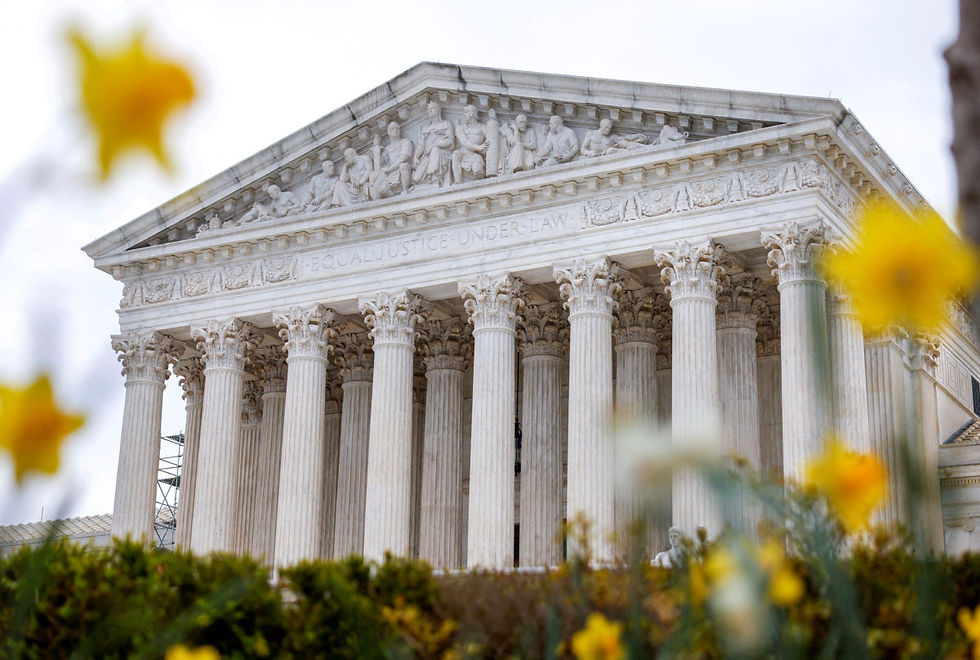The High Court’s Gatekeeping Challenge in Bowe v. United States
- Mathew Habib
- Oct 19
- 3 min read
Xylee Alvarez
Oct 2025
Does Congress’s ban on second or successive filings for federal inmates block the Supreme Court from review or even the inmate’s access to the courts?
The Supreme Court heard arguments in Bowe v. United States, a case at the intersection of federal habeas law, statutory interpretation, and access to justice. The questions before the court are two-fold: first, whether 18 USC § 2244 (b)(1), which bars claims in a second or successive corpus application under § 2254, applies to motions under § 2255, the federal inmate remedy as well. Second, whether § 2244(b)(3)(E), which says that the grant or denial of authorization by a court of appeals to file a second or successive application cannot be reviewed by the Supreme Court, stripped the court of jurisdiction when federal prisoners ask for review.
The petitioner, Michael Bowe, pleaded guilty in 2009 to robbery and firearm offenses, including § 924(c) for using a firearm during a crime of violence. Over time, Supreme Court decisions narrowed the definition of a “crime of violence” and undermined the basis for Bowes's § 924(c) conviction. Bowe then filed a motion under § 2255 to vacate his sentence, but because he had already attempted relief, the Eleventh Circuit treated his filing as a “second or successive” motion and dismissed it, holding that § 2244(b)(1)’s limitation on state-prisoner collateral claims also applied to federal prisoners.

The Supreme Court delves into the world of federal habeas law, once again.
During oral arguments, the Justices pressed deeply into the jurisdictional barriers and statutory text. For instance, Justice Sotomayor engaged with Bowe’s counsel directly about jurisdiction: “I don’t want you to give up on your first argument on jurisdiction…your brief gave me great pause.” The petitioner’s lawyer argued that reading § 2244(b)(1) to apply to § 2255 motions would expand the statue beyond its plain terms- and that if the Supreme Court was deprived of certiorari review under § 2244(b)(3)(E), it would raise serious constitutional questions about the Court’s role under Article III. Compared to the other side, the government took the positon that the statutory scheme created by the Antiterrorism and Effective Death Penalty Act (AEDPA) limits repetitious collateral review and gives Congress brosd discretion to structure the courts’ access. During rebuttal, the solicitor emphasized that allowing repeated filings and full Supreme Court review would “open the floodgates” to new rounds of litigation in federal prisoners’ cases.
With the lines narrow and the stakes high, the Justices returned to nuance asking, what counts as authorization by the court of appeals? What does second or successive mean in this context? Does the Supreme Court’s jurisdiction depend on whether the court of appeals considered the merits or dismissed for lack of jurisdiction? A striking moment came when Justice Alito asked whether Bowe’s reading “makes a hash of the procedure that Congress has prescribed” for second or successive § 2255 motions. This question underscored the procedural complexity that Bowe’s team argued that the 2244(b)(3)(E) bar did not apply to § 2255 motions; the government and many circuits currently treat it as such.
My impression is that the Court recognizes the procedural swamp in which federal habeas law now lies, and the perception among many practitioners that federal prisoners face a structurally disadvantageous regime. It feels unfair that federal prisoners often may be barred from raising a valid claim about their conviction simply because they attempted an earlier filing or because circumstances changed. It seems like an issue conflicting with the ideal of fairness, despite the law stressing finality. Concurrently, I also understand the government’s concern about judicial workload, finality, and predictability. If the Court interprets the statute too leniently, it might invite waves of collateral litigation and undermine the structure Congress created to limit it. It was jarring to me that the Court did not signal an easy way forward; many justices sounded skeptical of reading § 2244(b)(1)’s state-prisoner language into § 2255 by extension and equally cautious about stripping the Court of certiorari power under § 2244(b)(3)(E). This suggests the Court may craft a narrow, fact-bound decision, rather than radically overhauling the federal habeas framework.
I predict a 5-4 decision in favor of Bowe, with the Court’s liberal justices joined by Justice Gorsuch, who has shown some skepticism towards government overreach in criminal law. The majority will likely hold that § 2244(b)(1) does not apply to § 2255 motions and that § 2244(b)(3)(E) cannot block Supreme Court review of such cases.
This outcome would affirm that the Supreme Court retains its constitutional authority to hear petitions when liberty is at stake. It would also send the clear message that finality should never outweigh fairness, and access to justice must remain a living promise, not a procedural illusion.
Sources
“Bowe v. United States.” Oyez.Org, www.oyez.org/cases/2024/24-5438. Accessed 19 Oct. 2025.





Comments